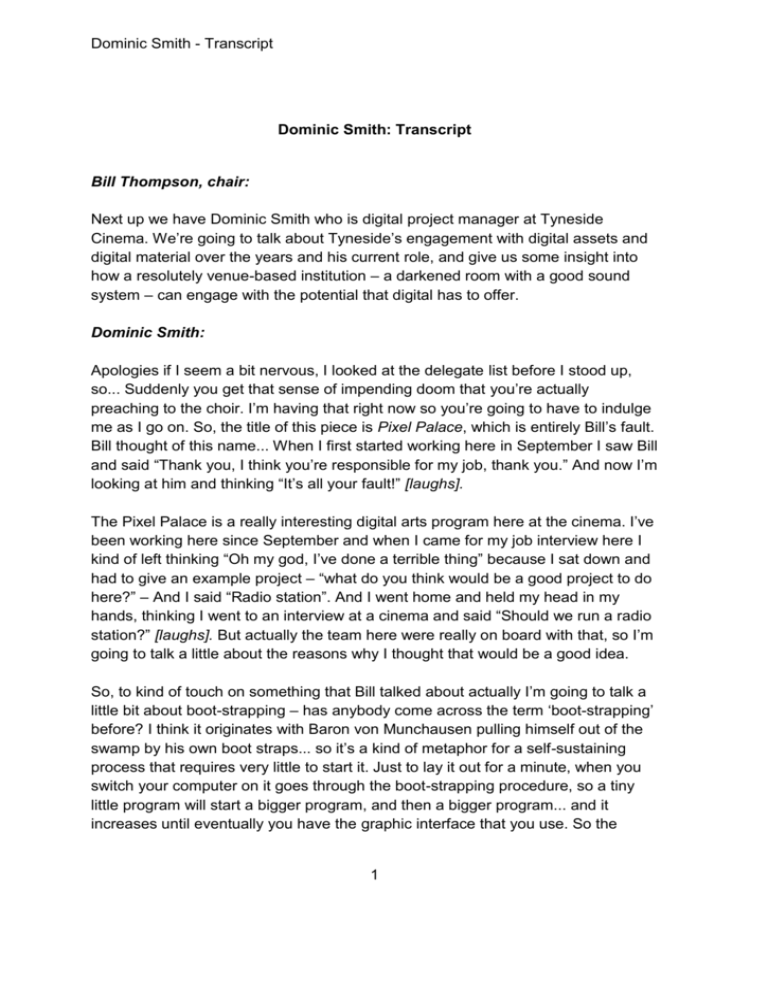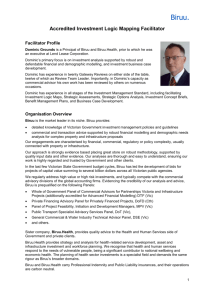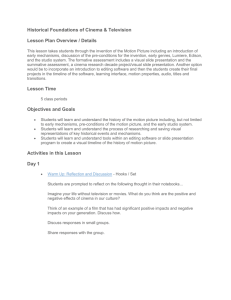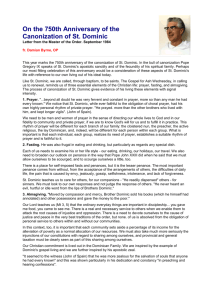Dominic Smith video transcipt
advertisement

Dominic Smith - Transcript Dominic Smith: Transcript Bill Thompson, chair: Next up we have Dominic Smith who is digital project manager at Tyneside Cinema. We’re going to talk about Tyneside’s engagement with digital assets and digital material over the years and his current role, and give us some insight into how a resolutely venue-based institution – a darkened room with a good sound system – can engage with the potential that digital has to offer. Dominic Smith: Apologies if I seem a bit nervous, I looked at the delegate list before I stood up, so... Suddenly you get that sense of impending doom that you’re actually preaching to the choir. I’m having that right now so you’re going to have to indulge me as I go on. So, the title of this piece is Pixel Palace, which is entirely Bill’s fault. Bill thought of this name... When I first started working here in September I saw Bill and said “Thank you, I think you’re responsible for my job, thank you.” And now I’m looking at him and thinking “It’s all your fault!” [laughs]. The Pixel Palace is a really interesting digital arts program here at the cinema. I’ve been working here since September and when I came for my job interview here I kind of left thinking “Oh my god, I’ve done a terrible thing” because I sat down and had to give an example project – “what do you think would be a good project to do here?” – And I said “Radio station”. And I went home and held my head in my hands, thinking I went to an interview at a cinema and said “Should we run a radio station?” [laughs]. But actually the team here were really on board with that, so I’m going to talk a little about the reasons why I thought that would be a good idea. So, to kind of touch on something that Bill talked about actually I’m going to talk a little bit about boot-strapping – has anybody come across the term ‘boot-strapping’ before? I think it originates with Baron von Munchausen pulling himself out of the swamp by his own boot straps... so it’s a kind of metaphor for a self-sustaining process that requires very little to start it. Just to lay it out for a minute, when you switch your computer on it goes through the boot-strapping procedure, so a tiny little program will start a bigger program, and then a bigger program... and it increases until eventually you have the graphic interface that you use. So the 1 Dominic Smith - Transcript process here, and I’m going to talk about this case study, is how we’re bootstrapping broadcast capacity. Now something that happened while I started kind of thinking about making notes for this talk – while I was making the notes this thing called Turntable FM appeared in the world – has anyone come across Turntable FM? Before I had finished writing, it was already locked into North America because of copyright issues, so we can’t go on it anymore. We could only go on it for a couple of weeks, but it looked like a lot of fun at the time [laughs]. Turntable FM was just basically a chat room where people could share content. So by sharing content, DJing for each other... and that desire to share your own material really drove it. And I think this was the first of many of these kinds of experiences that are going to be made available. So how are we doing this? One of the things we’ve been doing and kind of the ‘on button’ for the boot-strap process here has been to take advantage of the cinema program. We have directors coming and talking here quite a bit about their work so I was able to stream those talks for starters, just to get an idea of how the infrastructure would work in this building. The actual technology itself is believe it or not surprisingly easy, and has been around for a long time. There are a variety of servers you can use, from Showcast to iCast to Flash QuickTime – they all basically do the same thing, which is to serve up media to your computer. That works by sending a single signal to the server, and the server multicasts it out to as many listeners as you want. One of the game-changers recently has been the fact that people can listen to this stuff on their mobile devices, so it’s taken this experience from a ‘lean in’ experience, where you’re ‘leaning heavily into the computer’, hand on mouse, eyes glued to the screen, really getting a bad back - to a ‘take anywhere’ kind of experience, where I’ve been doing experiments on the small Metro route in the North of England to see where we get dips in signal, so to see how long people can listen to streams on their way to the cinema - so there’d be potential to have shows and events happening in the build up to people arriving here, to kind of extend that experience. And I’m pleased to say the only dip is in Jesmond. Of all places [laughter]. In terms of practicalities, I’m going to talk money here, and how small organisations could start this process. For a streaming server you’re looking at about £200 a year – not for a massive amount of listeners, but enough to get 2 Dominic Smith - Transcript started and to build that capacity and to build that experience. Again, podcasting is a great way of archiving live events – you’re going to need a few basic bits of equipment, which I’ve put in there. However, you’ve probably already got them. And then you’re going to need licensing, and if you’re looking at licensing then you start to look at different types of capacity. So the first stage in this boot-strap process would be to get the small microcaster licenses, which as you can see aren’t terribly expensive. I’m actually from an arts and curatorial background, so I’d like to talk a little bit about what that means to this program and what this means to broadcasting. So it turns out that arts are really good at finding new uses for technology really, aren’t they? I heard a talk a while ago by a chap called Miller Pukette, who is the developer of a program called Pure Data, which you can use to make your own multimedia software etc. He was probably quoting someone else, but he said “If you give an engineer a hammer they’ll read the instructions. If you give an artist a hammer he’ll just start hitting things with it.” Which is one of the first reasons that I’m really interested in working with the arts to find new and unexpected uses for this technology. I’d argue that art has been at the forefront of uses of new technology from the very onset, from the early Dial-A-Poem experiments by John Giorno, through to a chap called – I’ll struggle with this guy’s name – G.H Hovagimyan, who is a New York based artist I was looking after at an interview a couple of years ago. He had been involved in a bulletin board system in the ‘80s called “The Thing”. A bulletin board is kind of a pre-Internet, really early system for exchanging messages. And he had produced this piece called Barbie and Ken: Politically Correct- which you can imagine. He released a picture a week, which was like one of those Jackie annuals with speech bubbles etc. with Barbie and Ken in compromising positions. But the point that I’m going to make here is that he had gone around various galleries in New York, cap in hand, looking for an exhibition. He went to a gallery called YK Arts in Manhattan, and he was kind of begging for exhibition. And the door went, and the guy said “Oh just two minutes, I’ll go and answer the door” and then he looked at the computer to find that his work was the screensaver on the curator’s computer. So he had kind of bypassed the whole gallery system where you have to work your way through – he was already in the gallery without knowing it. So this is also the sort of thing that I’m quite interested in as broadcast as an artist’s space – not just a means of marketing artwork, but actually a space for artwork to exist in its own right. 3 Dominic Smith - Transcript And to get to that point really we have to look at the curated model. Now, I would argue that a curator’s job is to do with interpretation of the work as well, and there is so much going on out there that we’re really getting to the point now where we need to look at how we present our information to other people, and how we manage that content. And one of the important factors is gate-keeping. Now I’m from a sort of hacking, open-source background, and the idea of gate-keeping might seem quite foreign to that. But in actual fact, the open source models have very strong levels of gate-keeping to stop someone taking a piece of graphic software and turning it into a music sequencer, as people tend to have these crazy ideas on the internet. So it’s really important that we look at how we gate-keep that process. So revenue – I think probably a few people are interested in revenue, and I’m not sure that I have great news about it being a major source of revenue. What I can tell you is that not only will it bring you audiences but it also engages with the existing audiences, and finding out what they want, and building a sense of community around your work. One of the things we’re developing, and that I’ll talk about later, is we’re having the artists who are involved in the broadcast communicating at the same time as the broadcast is going out with the audience, at the same time, to build that sense of community and to have that conversation as the work is going out. And then doing that, I suspect that we will also get more people coming into the building at that point, as an organisation. I’ve put micropayments in there, because well, everyone puts micropayments in under the revenue heading, don’t they. But there is the possibility of desired content being funded by micropayments. Not in a kind of ‘pay-to-view’ way, but in a kind of ‘kickstarter’ way, where people would fund future content that they’re interested in being developed. So the future for Pixel Palace really, where we’re taking this at the minute, is that we’re going to be doing... well we’ve just successfully received a GFA application from the Arts Council, so one of the things we’re going to be doing with that is that we’re going to be releasing a series of monthly broadcasts and developing a series of monthly broadcasts, as we increase capacity. We’re in the process of redeveloping the websites, as you can see there- there’s just a tiny bit of it. But the important factor is the ‘Launch Radio’ button that we’re developing. So that will be one of the first things that happens when you go on the website, rather than “What’s on”, “Isn’t this cool?”, “Look at these pictures” – you’re going to be straight into that shared space. And this monthly broadcast is building up to a collaboration 4 Dominic Smith - Transcript with the AV festival, to produce a month-long 24hr a day broadcast in collaboration with Vicky Bennet, who goes under the name ‘People Like Us’, and we’re talking to Goldsmiths as well at the moment. So that’s where we’re heading in terms of capacity, and we’re building capacity – we’ve still got a way to go. One of the things that this enthusiasm led to was a larger project that is currently going under the title Popule! But a Latin title isn’t necessarily the most accessible title for large groups of people, so it’s now the Culture Network, and it’s working across the NGCV network in the Northeast of England – ‘NGCV’ is ‘Newcastle, Gateshead Cultural Venues’ – that’d be a real faux-pas to get that wrong at the moment! – And in doing that what we’re developing is a collaborative structure to do larger broadcasts and to prepare the way for internet protocol television. Which has taken on a life of its own at the moment. So there is that small grassroots, ‘getting things done’ level, and then there’s this much larger system that’s coming out of that enthusiasm. I’m not sure if I’ve gone over or under time... I’m fine... So, in 2012 after the monthlong broadcast we’ll be working more towards video as well. We have done a series of video streams from the cinema, and what we found was that the early stream process – it was really quite disheartening, just to let you know, if you do start doing this – you put a lot of effort into something and get like five listeners, which was devastating news at the time. But one of the important factors is to keep doing it, to keep going, and to keep going regularly, because people expect it to be a place to go to at a certain time to find certain things. And if you don’t provide those things they don’t come back. So you just have to keep going and going and going. We started off getting five; the last time we did it we streamed Mike Hodges in the cinema and we went over capacity – we couldn’t keep... the server wouldn’t let anyone else in to listen and to watch. Especially when Alan Armstrong came on, telling jokes about bees for some reason, we maxed out. And the chatroom aspect of it was really useful as well to keep that conversation going and to make people who weren’t physically in the venue feel like they were still part of the conversation, still part of the event. I think that’s all from me! 5








